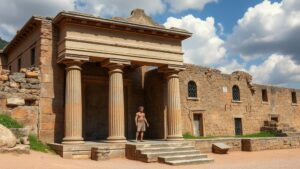Searching for the “Silver Steps,” a path of gleaming rock leading to a lost temple in South America.
Searching for the Silver Steps: A Quest for a Lost Temple in South America
The allure of the undiscovered has always captivated adventurers and historians alike. Among tales of ancient civilizations lies the legend of the Silver Steps, a mystical pathway made of gleaming rock, rumored to lead to a long-lost temple in the heart of South America. This article will explore the historical context, the geography of the search, and the implications of discovering such a site.
The Legend of the Silver Steps
The Silver Steps are said to be a remnant of an ancient civilization, possibly the Incas or even pre-Incan cultures, which flourished in the Andean region. Historical records suggest these cultures possessed advanced knowledge of architecture and stonework. The allure of the Silver Steps lies not only in their physical manifestation but also in the mystery surrounding the temple they purportedly lead to.
According to lore, the steps are adorned with minerals that shimmer in the sun, resembling silver. They are rumored to be hidden deep within the cloud forests of Peru, potentially near the vicinity of Cusco, an area rich in archaeological significance. In various accounts, previous explorers have described the steps as both a navigational guide and a spiritual pathway, leading the faithful to a sanctuary that embodies the lost wisdom of an ancient people.
Historical Context and Significance
The search for the Silver Steps is not merely a quest for treasure but a dive into historys depths. The Incas, who thrived between the 15th and 16th centuries, built an extensive road system across the rough terrain of the Andes, facilitating trade and communication between their vast territories. This network was not only functional but also sacred; many paths were believed to lead to holy sites.
Also, the region around Cusco is home to significant archaeological sites, such as Machu Picchu, which draw millions of visitors annually. According to a report by the Peruvian Ministry of Culture, Machu Picchu received over 1.5 million visitors in 2019 alone. The potential discovery of the Silver Steps could augment the historical narrative surrounding the Incas, providing insights into their socio-political structure and religious practices.
The Geography of the Search
South America features diverse ecosystems and geographical challenges that play a crucial role in the search for the Silver Steps. The Andes mountains rise sharply, creating a formidable barrier that has preserved many ancient sites yet also made them difficult to locate. The cloud forests, characterized by high humidity and rich biodiversity, create an ecosystem that can cloak ancient pathways in thick vegetation.
Notably, the area is not only known for its biodiversity but also for its geological formations. rocky landscape often contains mineral deposits that can shine under certain conditions, lending credence to the legend of the Silver Steps. But, explorers must navigate environmental hazards such as steep terrains, unpredictable weather, and a variety of wildlife.
Real-World Applications: The Quest for Knowledge
The ongoing exploration for the Silver Steps has greater implications beyond unearthing artifacts. The pursuit integrates archaeology, anthropology, and environmental science, contributing to a holistic understanding of ancient societies and their interactions with their environments. Teams of archaeologists, historians, and local guides often collaborate, blending modern technology with traditional knowledge to increase the chances of success.
Also, discovering the Silver Steps could have significant implications for tourism and conservation efforts in these underappreciated regions. Responsible tourism can lead to economic benefits for local communities while fostering a greater appreciation for historical sites.
Actionable Takeaways
- Understand the importance of the legend of the Silver Steps as part of South Americas rich cultural heritage.
- Explore the advancements in archaeological methods, such as ground-penetrating radar (GPR), that can facilitate the search for hidden pathways and sites.
- Engage with local conservation efforts to protect the ecosystems surrounding potential archaeological sites, ensuring both historical preservation and environmental protection.
In pursuing the legend of the Silver Steps, adventurers and scholars are not merely hunting for artifacts; they are searching for the stories, histories, and traditions that resonate through time, potentially shedding light on lost civilizations that once thrived in the heart of South America.


